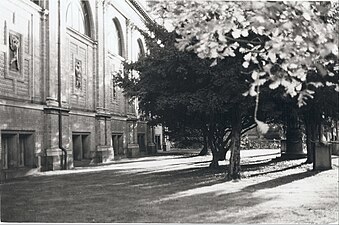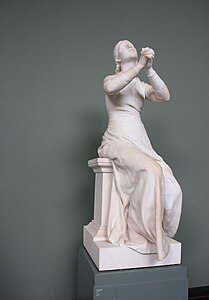Ny Carlsberg Glyptotek
You can help expand this article with text translated from the corresponding article in Danish. (January 2017) Click [show] for important translation instructions.
|
 New Carlsberg Glyptotek | |
 Interactive fullscreen map | |
| Established | 1897 |
|---|---|
| Location | Copenhagen, Denmark |
| Coordinates | 55°40′21″N 12°34′19″E / 55.67250°N 12.57194°E |
| Type | Art museum |
| Key holdings | Rodin, Little Dancer of Fourteen Years, Woman with a Flower |
| Collections | Ancient Greek sculpture, Roman sculpture, Post-impressionists, Danish Golden Age |
| Collection size | >10,000 |
| Visitors | 514,608 (2019)[1] |
| Founder | Carl Jacobsen |
| Director | Gertrud Hvidberg-Hansen |
| Chairperson | Christine Buhl Andersen |
| Architect | Vilhelm Dahlerup (1897), Hack Kampmann (1906), Henning Larsen (1996) |
| Website | www |



The Ny Carlsberg Glyptotek ("ny" means "new" in Danish; "Glyptotek" comes from the Greek root glyphein, to carve, and theke, storing place), commonly known simply as Glyptoteket, is an
Primarily a sculpture museum, as indicated by the name, the focal point of the museum is antique sculpture from the ancient cultures around the
The French Collection includes works by painters such as
History
First Glyptoteque
Carl Jacobsen was a dedicated art collector. He was particularly interested in antique art, but over the years he also acquired a considerable collection of French and Danish sculptures. When his private villa in 1882 was extended with a winter garden, sculptures soon outnumbered plants in it. The same year the collection was opened to the public. In the following years the museum was expanded on a number of occasions to meet the need for more space for his steadily growing collections. In 1885 his 'house museum' had grown to a total of 19 galleries, the first 14 of which had been designed by Vilhelm Dahlerup while Hack Kampmann had built the last four as well as conducted a redesign of the winter garden.[2]
New museum

In spite of the many extensions, it was finally clear the existing premises were inadequate and that a new building was needed. On 8 March 1888 Carl Jacobsen donated his collection to the Danish State and the City of Copenhagen on condition that they provided a suitable building for its exhibition. Copenhagen's
It was Carl Jacobsen who chose the name for the museum, with inspiration from Ludwig I's Glyptothek in Munich, as well as Vilhelm Dahlerup as the architect for the assignment. The moat around the radan was filled and the new museum opened first on 1 May 1897. At first it only included Jacobsen's modern collection with French and Danish works from the 18th century.
In January 1899 Carl Jacobsen donated his collection of Antique art to the museum which made an expansion necessary. It was designed by Hack Kampmann while Dahlerup designed a winter garden which connected the new wing to the old building. It was inaugurated in 1906.
In 1996 the museum was once again extended, this time with an infill constructed in one of its courtyards to the design of
Architecture
The building is often noted for its elegance in its own right and the synthesis it creates with the works of art.
The
The Kampmann Wing is a more simple, neo-classical building, built as a series of galleries around a central auditorium used for lectures, small concerts, symposiums and poetry readings.
The two wings are connected by the Winter Garden with mosaic floors, tall palms, a fountain and topped by a dome made in copper and wrought iron.
The Henning Larsen Wing is a minimalistic infill, built in a former inner courtyard and affording access to the roof. Official meetings and banquets sometimes take place in the Glyptotek, such as the certification of Polio-free Europe, 21 June 2002.
Collections
The Ny Carlsberg Glyptotek's collections comprise more than 10,000 works of art.
Antique collection
The Antique collection displays sculptures and other antiquities from the ancient cultures around the Mediterranean.
The extensive Greek, Roman and Etruscan Collection comprises marble statues, small
The Egyptian Collection comprises more than 1,900 pieces, dating from 3000 BCE to the 1st century CE and representing both
The Near Eastern Collection spans a period of 7150 years, the oldest artifact being from 6500 BCE and the youngest being from 650 CE, featuring such cultures as the
French Collection

The main focus of the French Collection is 19th-century French painting and sculpture. The painting collection contains works by such painters as David and Manet, as well as a large collection of Impressionist painters such as Monet, Cézanne and Bonnard. The single painter represented with most paintings is Paul Gauguin with more than 40 works. The museum also holds a large collection of French 19th-century sculpture by artists such as Carpeaux and Rodin, the Rodin collection being one of the largest in the world, as well as a complete collection of Degas' bronze sculptures.[10]
Danish Collection
The Danish Collection contains a large collection of Danish Golden Age paintings by painters such as
European Collection
The European Collection comprises works from the 18th to the 20th century. Represented sculptors include Neoclassicists such as Canova, Sergel, Carstens, Flaxman, Rauch and Baily, as well as Modernists like Meunier, Klinger, Picasso and Giacometti.
The collection also comprises a small collection of Modern paintings of artists such as Arp, Ernst, Miró, Poliakoff and Gilioli.
Auditorium
Concerts
The Auditorium is mainly used for classical concerts, including the Helge Jacobsen concert series. Helge Jacobsen Concerts have included the Austrian Hagen Quartet,[11] the Russian violinist Alina Ibragimova, the French pianist Cédric Tiberghien, the Russian bariton Sergei Leiferkus,[12] the French Ysaÿe Quartet[13] and German tenor Jonas Kaufmann[14] among others.
The Ny Carlsberg Glyptotek is in general noted for its good acoustics, both in the auditorium and in the surrounding long halls. The Auditorium has been used as a rehearsal room by the
Occasionally the Auditorium is also used for other musical genres, such as the Danish Klezmer group Mames Babegenush.[16]
Other cultural events
The Auditorium is also used for other cultural events, such as poetry readings, lectures and debates.
In popular culture
The museum is used as a location in the films
The building was the inspiration for the set design of the Valkyries' Rock in
Gallery
-
Winter garden, Ny Carlsberg Glyptotek
-
Paul Gauguin: Bord de mer I (Seaside I)
-
Part of the Ny Carlsberg Glyptotek garden
-
Fate
-
Portrait of Caligula (with traces of polychromy), AD 37-41
-
Herman Wilhelm Bissen:
Prince Paris with apple -
The Absinth Drinker
-
Nasothek display of noses used for restoration
-
Girl with bird
-
Fidelity
-
Fidelity (close-up)
-
Prudence
-
Beauty of Palmyra
See also
- Carlsberg Foundation
- The Carlsberg District
- H. C. Andersens Boulevard
- Paul Dubois (sculptor)
- Laurentian Sow (sculpture)
References
- ^ (in Dutch) [1] 25 April 2021.
- ^ "Ny Carlsberg - Carlsberg Museum". Carlsberg Vores By. Archived from the original on 2009-04-22. Retrieved 2009-05-09.
- ^ "De bastionære fæstninger 1600-1870". Selskabet for Københavns Historie. Archived from the original on 2013-09-21. Retrieved 2010-01-26.
- ^ "Museet bliver til". Nt Carlsberg Glyptotek. Archived from the original on 2010-09-26. Retrieved 2010-01-26.
- ^ "The Henning Larsen Wing". Archived from the original on 2008-03-02. Retrieved 2009-01-08.
- ^ "Ny Carlsberg Glyptotek Renovation". Archived from the original on 2008-12-02. Retrieved 2009-01-08.
- ^ "BONDE + LJUNGAR Arkitekter MAA". www.bonde-ljungar.dk. Retrieved 2018-02-28.
- ^ "Ny Carlsberg Glyptotek". cofman.com. Retrieved 2009-06-15.
- ^ "Den ægyptiske samlings 125 års-jubilæum". Ny Carlsberg glyptotek. Retrieved 2009-05-12.
- ^ "Ægyptologisk tidsskrift Indhold: e". Papyrus 16.2 December 1996/Geoffrey T. Martin. Retrieved 2009-05-12.
- ^ "Hagen Quartett på Glyptoteket". Ny Carlsberg Glyptotek. Retrieved 2010-04-22.
- ^ "Helge Jacobsen-koncert med Sergej Leiferkus og Julius Drake". Ny Carlsberg Glyptotek. Retrieved 2010-04-22.
- ^ "Ysaÿe-kvartetten gæster Glyptoteket". Ny Carlsberg Glyptotek. Retrieved 2010-04-22.
- ^ "Koncert med tenoren Jonas Kaufmann". Ny Carlsberg Glyptotek. Retrieved 2010-04-22.
- ^ a b "The Ny Carlsberg Glyptotek - ancient art in beautiful acoustics". My Copenhagen. Retrieved 2010-04-22.
- ^ "Balstyrisk klezmer på Glyptoteket". Ny Carlsberg Glyptotek. Retrieved 2010-04-22.
- ^ "Flyptoteket". danskefilm.dk (in Danish). Retrieved 16 March 2017.
External links
- Museum website
- Renderings in the Danish National Art Library
- Virtual tour of the Ny Carlsberg Glyptotek provided by Google Arts & Culture
 Media related to Ny Carlsberg Glyptotek at Wikimedia Commons
Media related to Ny Carlsberg Glyptotek at Wikimedia Commons














